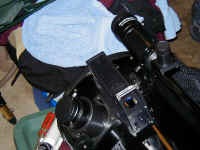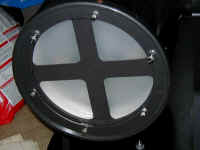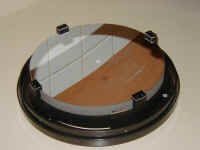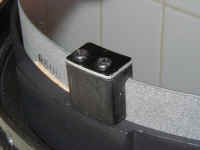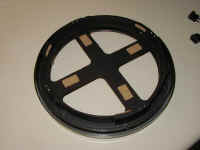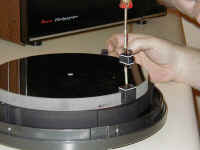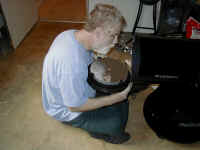TTG Home Ľ Robert Home Ľ Daynotes Journal Home Ľ Journal for Week of 4 March 2002
 |
Week of 4 March 2002 Latest Update: Friday, 05 July 2002 08:28 |
| Linux Chronicles | |||
|
Monday, 4 March 2002 [Last
Week] [Monday] [Tuesday] [Wednesday]
[Thursday] [Friday] [Saturday]
[Sunday] [Next Week] |
|||
| 9:22
- Barbara always warns people about the dangers of allowing
a dog to ride in the bed of a pickup truck. Subscriber Allen Moore sent me
this
horrifying story of what happened to one Border Collie when her owner
did just that. Please, if you care about your dog, don't ever put it in
the back of a pickup unless you're using one of the restraining harnesses
sold by pet stores and mail-order pet supply places.
Even then, it's better to let the dog ride in the passenger cabin. Sure, the dog may have muddy paws. So what? We keep old bath towels in our trucks, and it's the work of a moment to wipe the dog down. Even if you have to let the dog ride with dirty paws, it's not that difficult to vacuum the seats, and it may save a trip to the emergency vet, or worse.
Intel announced prices cuts today, as expected. Prices on everything but the Celerons remain the same. Celeron prices are now 7% to 18% lower, depending on speed. A Celeron/1.0G now sells in trays of 1,000 for $64 per unit, which is simply incredible. All of the benchmarks and AMD versus Intel stuff aside, the simple fact is that very few people really need anything more than a 1 GHz processor. Pop one of these inexpensive processors into a D815EEA2U motherboard with 256 MB of SDRAM, and you have the core of an inexpensive system that'll probably be sufficient for anything you want to do.
Barbara and I removed the primary mirror cell from our scope yesterday in order to re-install the steel backing plate. I'd removed it a week or two ago, and found that the scope no longer balanced at all with it missing. The plate itself is about 12" in diameter and about 1/16" thick. I seem to remember that steel weighs about 490 pounds per cubic foot, which means the plate must weigh about two pounds. That seems about right. Here's the front end of the scope, the weight of which causes the balance problem. That's a 2" focuser on the left (with no eyepiece installed). The Telrad reflex sight is in the middle, and the 9X50 optical finder on the right. The front end of the scope is resting on a green plastic storage bin, because the scope is front heavy even before I remove the mirror cell from the back of the scope. Here's what the back of the scope looks like with the plate removed. The plate is actually not needed to protect the mirror, and slows cool down. A scope doesn't provide good images until the mirror reaches ambient temperature, which is why I removed the plate to begin with. Those six screws are used to collimate (align) the primary mirror. The three screws with the larger heads are spring loaded. Turning them tilts the mirror one way or another. Usually it takes only a fraction of a turn to adjust the mirror properly. The three screws with the smaller heads lock the mirror into place once its angle has been adjusted with the other screws. In order to re-install the plate, I had to pull the primary mirror and cell. Here's what the primary mirror looks like in its cell. Those four little clips around the perimeter of the mirror prevent it from falling out. Here's a close-up of one of the mirror clips. The clip itself is rubber. It just barely touches the mirror. If it applied even an ounce of pressure, that'd be enough to twist the mirror out of shape and yield poor images. The small metal plate on top of the mirror clip serves to give the screws a solid surface to hold against. Once I removed the mirror clips, I could just lift the mirror out of the cell. Here's what the mirror cell looks like with the primary mirror removed. Once I put the backing plate in place, I reinstalled the mirror clips (very carefully). Having a screwdriver and screws anywhere near a primary mirror is scary. One slip, and you've destroyed your primary mirror. A mass-produced 10" primary mirror costs $350 or $400. A premium quality 10" primary costs from $750 to $1,200. This is a mass-produced primary mirror, but it happens to be a very good one, so I was very careful. Once I reassembled the mirror cell, this time with the backing plate re-installed, I put the primary and mirror cell back into the scope. That little white spot clearly visible in the center of the mirror is an ordinary paste-on notebook reinforcement ring. It marks the exact center of the mirror, and is needed when collimating. It doesn't affect image quality, because it's always in the shadow of the secondary (diagonal) mirror, which directs the light from the primary mirror at a 90 degree angle into the focuser. With the backing plate re-installed, the scope now balances adequately with no eyepiece installed. But I'm afraid that it won't balance once a heavy eyepiece like the 14mm Pentax XL, so I may have to install a counterweight at the rear. The Telrad, 9X50 finder, and Pentax eyepiece each weigh about a pound, which is a lot of weight to put on the front end of the scope. We'll see. But at least it's now balanced a lot better than it was.
It's back to work for me. I have to finish the USB chapter, so I'd best get started. It'll be another slow week around here.
11:19 - Arrghhh. I really must do something about my main system. As long time readers will recall, a year or so ago I started having overheating problems with my then-main system, a dual-processor Pentium III box. I was in a hurry then, as usual, so I grabbed a test-bed box that happened to already have Windows 2000 and Office 2000 installed on it. That test-bed wasn't a cutting edge system even then--a single processor SE440BX-2V motherboard with a Pentium III/750 or /800 in it and IDE drives. But it worked, it was available, and I could turn it into my main system with a few minutes work instead of having to build myself a new system. A couple of months ago, this system started spontaneously rebooting itself. Now it seems that every third or fourth morning when I come into my office I find it sitting at a login prompt. Annoying as that is, it just did something that really annoys me. I periodically archive all my old email out of Outlook's main pst file into an archive PST. The last time I did that was back at the first of January. When the first of February rolled around, I'd ordinarily have archived, but I had higher-priority things to do. So today I decided that I'd better archive before my main pst file got outrageously large. I started the archive process and was working on another system, deleting old web log files from Pournelle's and my servers at pair Networks, when I heard my main monitor click. I looked over, and sure enough it was rebooting itself. Double arrrrghhh. Although I'd done an xcopy backup of all my data before I started archiving, the archive process itself runs while Outlook is open, so Outlook had downloaded some new mail while it was archiving. Although nearly all of that was just listserve mail, I decided to try to save it. So I ran scanpst.exe on the working pst file. It chugged away for quite a while and then reported some serious errors, which wasn't unexpected given that the system had crashed with both the main and archive pst files open on different computers, and items being transferred from one to the other. After thinking about it, I decided just to revert to the older saved versions of the main and archive pst files. I lost at most a few listserve messages, which is no big deal. I can't really blame Outlook for the problem. It's not unreasonable for it to expect both systems to continue functioning during an operation. And in fact everything would probably have been fine if I'd used scanpst.exe to fix the corrupted pst files. It generally does a good job. But it was safer to revert to older copies of the files, and the loss by doing so was trivial. But it did cost me ninety minutes or so that I'd have preferred to spend working on my chapter. Oh, well. [Top] |
|||
|
Tuesday, 5 March 2002 [Last
Week] [Monday] [Tuesday] [Wednesday]
[Thursday] [Friday] [Saturday]
[Sunday] [Next Week] |
|||
| 9:19
- Jerry Pournelle writes his BYTE column once a month,
usually from about the first through the sixth. BYTE then breaks that
column up into weekly installments and posts a new installment each week
until the new column arrives from Jerry the following month. Before
submitting them to BYTE, Pournelle sends his columns out for "sanity
checks" to me and a few of his other friends.
I usually comment on technical issues, and sometimes make gratuitous suggestions. I made one of those last month, when I commented to Jerry that his characterization of VIA chipsets as deficient, although true enough, would cause a firestorm. Well, actually I didn't say "fire", but that's close enough for a generally clean page like this. As I expected, the shrieks of gored oxen were heard soon after that portion of the column appeared. I received the following forwarded email from Jerry yesterday:
I made the following response to Jerry: -----Original Message----- Well, I think the guy's email address says it all. Of course you have to install the chipset drivers provided by the motherboard manufacturer. That goes without saying. But the simple truth is that VIA chipsets, even with the latest drivers installed, are much less reliable and compatible than good chipsets like those from Intel and AMD. VIA chipsets are third-rate, whether they support AMD or Intel processors. There are some decent chipsets out there for AMD processors. The AMD760 would be wonderful, if anyone actually made a board that used it. They don't. Instead, they use the AMD760 northbridge, but in order to save a few bucks they use a VIA southbridge instead of the matched AMD southbridge. I don't recommend ALi chipsets or VIA chipsets, because both are of poor quality in terms of stability and compatibility. Anyone who denies that isn't living in the real world, as a quick Google search illustrates. SiS chipsets are a different matter. Historically, most of them have been garbage, intended for very low-end systems sold through mass merchandisers. However, the SiS735, while cheap, is an extraordinarily good chipset for AMD processors. It's as fast as the AMD760, and appears to be just as stable. All chipsets have bugs and conflicts, but the SiS735 (and presumably its follow-on, although I haven't tested it) is a first-rate chipset for the Duron and Athlon. The AMD760MP and AMD760MPX are also very good chipsets, although the AMD760MPX has had some teething problems, such as USB incompatibilities. I have no doubt that the next stepping of the AMD760MPX will be solid. But as for VIA chipsets, no way. I do recommend them occasionally, but only to people I don't like. -- I'm just surprised that Jerry hasn't been slashdotted again, or at least he hasn't so far. Of course, that's probably because Linux folks are smart enough to recognize a deficient chipset when it bites them. Predictably, someone has already called Pournelle an Intel shill. Although he always pretends it annoys him to be called a shill, in fact I suspect it pleases him. I know it does me. I've been called an Intel shill and an AMD shill, all in the same week, sometimes in the same day. I'm frequently accused of being a Microsoft shill, but on the other hand, people also frequently accuse me of being a mindless Microsoft hater. What accusations like that mean to a journalist is that he's doing his job. Ideally, one wants the zealots on all sides to be upset with one, because that means one is writing the truth. If there's one thing a zealot of any stripe can't stand hearing, it's the truth when that truth is unflattering to his preconceived notions. So I say to Jerry, "Keep it up. You're doing your job as it should be done."
Last night, in response to a USB troubleshooting question on the messageboard, I wrote the following:
Which pretty much sums up the situation.
Arrrrghh. Of course it is, and this time it's screwed up in the local copy rather than just on the server. And FrontPage 2000 is determined to keep it screwed up. I just tried to change the absolute path to a relative path, and guess what? FrontPage accepted the change, but when I looked at image properties again, it had changed it back to an absolute path. I hate it when it does stuff like that. It may be the only solution is for me to change the HTML code with Notepad and use my ftp client to upload the corrected page to the server. Why does FrontPage do this? Why? I never touched that image. I had it correct on last week's page. I made a copy of last week's page for this week, and did nothing to the HTML code for that image. I never touched it. I never even looked at it. So why is last week's page fine and this week's page screwed up, not just on the server, but on the local copy? I know for a fact that FrontPage's ftp publishing stub, which is pathetic to start with, is what screwed me up last time. I checked the actual code on the local server and compared it to that on the remote server, so it had to be the ftp publishing client. But this time, the code is screwed up locally, which means that a different bug caused this problem. FrontPage, it seems, is determined to screw up absolute versus relative paths.
The Critical Need Detector strikes again. Yesterday, the main system in my office spontaneously rebooted, so I moved to the den to use the system there. This morning, I sat down as usual in the den to read the morning newspaper and check my email. One of the messages I got was from Pournelle, with a copy of his most recent partial column draft attached. I opened the attachment in Word directly from the email message and then attempted to do a Save-As to stick the document in the appropriate directory on the server. When I clicked the down arrow in the Save-As dialog, Word locked up. After waiting a few seconds for the drop-down list to appear, I finally right clicked on the Task Bar, choose Task Manager, and displayed the applications page. Word was listed as "Not responding". No surprise there. It does lock up occasionally. So I told Task Manager to kill the application, and the fun began. It couldn't kill it, and Task Manager itself locked up. Oh, well. I brought up another instance of Task Manager and tried to kill the Winword.exe process. No dice. So I finally tried to shutdown the system. No joy. I ended up having to power reset the computer. The system booted apparently normally, I logged in, and eventually my desktop appeared. A few of my desktop icons had had a different icon substituted, but otherwise things appeared to be normal. Until, that is, I tried to start a program. I couldn't run anything. Clicking a desktop icon simply gave me an hourglass for a moment, and then nothing. Nothing showed up even in the process list. Clicking the Start button depressed it and left it depressed, but it didn't display a menu. Eventually, I decided to shutdown. At that point, I got a dialog telling me that Explorer.exe wasn't responding, and I eventually had to power reset the system again. To make a long story short, I tried many restarts, including in Safe Mode, and the system is completely hosed. The underlying OS is running fine--I can view a directory list from another machine-but the GUI is completely broken. So now my main office system, upon which I'm writing this, is subject to spontaneous reboots at any time, and my secondary system in the den is unusable. Critical need detector, indeed. [Top] |
|||
|
Wednesday, 6 March 2002 [Last
Week] [Monday] [Tuesday]
[Wednesday] [Thursday] [Friday]
[Saturday] [Sunday] [Next
Week] |
|||
| 9:10 -
Well, that was the easiest fix ever. When I left my den system yesterday
morning, it was running Windows 2000, but with a dead GUI. I verified that
by accessing a share on the den system from a system in my office. No
problem getting to the machine, but the system remained unusable.
Rebooting didn't help, nor was I able to do anything in safe mode.
So I spent the day working in my office. My main system behaved. Not even one spontaneous reboot. Just before dinner, I came out to take a look at the den system, carrying my Windows 2000 CD. I planned to try a repair installation. The screen had blanked, and when I moved the mouse, my desktop appeared normal. All of the scrambled icons were back the way they are supposed to be. I could click a desktop icon to run a program with no problem. Same thing with the Start menu, which earlier that day had been totally non-responsive. Just on general principles, I decided to re-install Windows 2000 SP2 on the theory that it'd replace most of the important system files, although I can't see that doing that made any difference. My den system fixed itself. That's the first real case of temporary insanity I've ever witnessed.
Mirabile dictu, it appears that Hewlett-Packard has finally released Windows 2000 (and Windows XP) drivers for the HP6200C scanner, and only two years late. Well, actually only 18 months late, because the drivers are dated last October, not that HP bothered to tell me about them despite the fact that I was signed up to receive email notifications from them when any new software was released for the HP6200C. The bad news is that the download is something like 46 MB. The good news is that the same file works with either Windows 2000 or XP. HP describes the file as "HP PrecisionScan Pro Software for the 6200c/6250c series of scanners for both SCSI and USB interfaces." Finally. I posted this information out on the backchannel last night, and one of the guys told me that his HP 6200C works fine with XP out of the box. I may give that a try.
Back to work on the USB chapter, which is starting to take shape. As usual, my problem is going to be "what to leave in and what to leave out". I'll post the completed manuscript to the subscriber page once it's ready to look at. [Top] |
|||
|
Thursday, 7 March 2002 [Last
Week] [Monday] [Tuesday]
[Wednesday] [Thursday] [Friday]
[Saturday] [Sunday] [Next
Week] |
|||
| 9:50 -
Late start this morning because I was running a sanity check on
Pournelle's 3/4-finished column and reading/responding to emails. When I
fired up Outlook this morning, I had 287 new emails from overnight. That's
high even for me. Of those, probably 250+ were either spam or listserve
messages, but even so I had two or three dozen real emails to deal with.
The USB chapter is coming together pretty well. I hope to have a final draft finished this afternoon or this evening. Then I'll send it off to my tech reviewers, as well as posting it on the Subscribers' page. I need to have it vetted pretty quickly, because I promised my editor yesterday that I'd have it up to them by Friday afternoon, with all tech review comments reviewed and if necessary incorporated. If you're a subscriber and have time to do a quick read-through, I'd appreciate any comments about stuff I got wrong, left out, or whatever.
Organization of the Winston-Salem Astronomical League proceeds apace. In what must be an all-time record, I registered the domain wsal.org yesterday morning at 11:06 a.m. and found that it was already responding to DNS queries as of 20:45 last night. Of course, that just means that DNS changes have propagated to my server, and not necessarily to every server. Still, that's a fast start. So far, the Winston-Salem Astronomical League web page is just a placeholder, but there'll be more there as I get time to do it. And the mail does work. I just sent a test message to thompson at wsal dot org and it arrived in nothing flat.
[Top] |
|||
|
Friday, 8 March 2002 [Last
Week] [Monday] [Tuesday]
[Wednesday] [Thursday]
[Friday] [Saturday] [Sunday]
[Next Week] |
|||
| 8:50 -
I got the USB chapter finished up and posted it on the
Subscribers' page, where it'll remain only briefly. I promised O'Reilly
that I'd have the final version, with any corrections necessitated by tech
review comments incorporated, by this afternoon. Thanks to all the people
who have already submitted comments. I'll be incorporating the necessary
changes this morning and getting the final manuscript off to O'Reilly this
afternoon.
I am completely whacked, and just trying to hold it together until I get the final version of the final chapter submitted. There'll be more to do after that, of course. There always is. But the book is substantially finished now. As to when it will appear in the bookstores, I have no idea. I'm hoping for next month, but it'll probably be May. Barbara left yesterday afternoon. She has a conference in Charlotte today. I'm not sure when she'll be home. She offered to kennel the dogs so that I could work uninterrupted, but I prefer to keep the dogs here with me. They can be disruptive, but I like having them around, and I dislike kenneling dogs. I always think they'll feel abandoned. All three dogs have been extremely good since Barbara left. Not a peep out of them all yesterday afternoon. Now, as usual after completing a book, I realize that I'm unemployed. Of course, that's true for a freelance author every morning when he wakes up, but it's more obvious when you've finished a book and are wondering what to do next. In my case, I'm going to pursue Linux seriously, but that doesn't pay the bills. So I'll also need to come up with another book to write, probably for O'Reilly.
As long-time readers will recall, I've been predicting the eventual demise of PC Magazine for something like three years now. Well, it looks as though PC Magazine (as well as other ZD publications) is nearing that point, as this article makes clear. Things may come to a head as soon as next Friday, unless someone bails them out. According to that article, ZD revenues are dropping and losses are increasing. For 2000, ZD lost $28.8 million on revenues of $353 million. Last year, ZD lost an incredible $415.7 million on revenues of only $224.6 million, although much of that loss was attributed to restructuring charges and other one-time write-offs. Still, the proverbial handwriting is on the wall. The article attributes the problems of ZD to a very bad advertising market, but in my opinion the real problem is that ZD publications have become increasingly irrelevant. I know that Barbara and I long ago cancelled our subscriptions or decided just to allow them to lapse.
More bounces from a subscriber mailing I did yesterday. It appears that @home has finally well and truly disappeared. If one of these is your address, please send me an updated address for my records.
[Top] |
|||
|
Saturday, 9 March 2002 [Last
Week] [Monday] [Tuesday]
[Wednesday] [Thursday] [Friday]
[Saturday] [Sunday] [Next
Week] |
|||
| 8:56 -
Barbara arrived home late yesterday afternoon. The dogs and I
barked in greeting and did our little circle-dance to greet her.
After I finished up the final chapter and got it off to O'Reilly yesterday, I decided it was time for a bit of maintenance. My Outlook PST file was getting a bit large, so I decided to archive it. As usual, I did an xcopy backup first to copy both the main PST and my archive PSTs to another drive before proceeding. I also ran the scanpst.exe Inbox Repair Tool again both the main PST and the archive PST I'd be archiving to. Both of them got a clean bill of health. The main PST was about 120 MB and the archive PST about 500 MB. So then I started the archiving procedure by telling Outlook to archive all messages older than 3/1/2002 from the Mailing Lists folder and its subfolders. It got through several subfolders normally and then encountered the Talking Telescopes folder (no, the mailing list isn't about telescopes that talk, although I suspect that day will soon arrive; it's for talking about telescopes). That folder had something like 4,000 messages in it, dating back to 1 January. Outlook began archiving that folder normally, but before it moved all the old messages from that folder it suddenly just jumped to another folder and started archiving it. After a minute or so, Outlook blew up and displayed an error message about the archive failing because of errors in the destination PST. That seemed odd, but I decided just to run scanpst.exe again against the archive PST to fix it. Scanpst.exe found and fixed the errors, or so it said. Then I restarted the archive process, which again proceeded normally for a while before jumping from an uncompleted folder to another folder and then blowing up. Run scanpst.exe again, this time against both the main PST file and the archive PST file. No errors in the main file, and the errors in the archive PST file were supposedly fixed. Restart the archive, and it blows up again. Delete both archive and main PST files, revert to the backup copies, and restart the whole process. It blows up again. Delete both PSTs, revert once again to the backup copies, run scanpst.exe against both of them, and find there are no errors in either. Restart the archive process yet again. Again it blows up. Okay, I may learn slowly, but I do learn. All this thrashing about has taken quite a while, because running scanpst.exe against large files takes significant time. At this point, I'm beginning to wonder if I'll ever be able to archive my main PST again, or if it'll just continue to grow like Topsy. So I decide to rename the main archive PST file from archive.pst to archive-2001-20020308.pst and let Outlook archive from the main PST file to an empty archive.pst file. I do that, and the archive process completes without error, getting my main PST down to 20 MB or so after I compress it. So, I can archive data, which is good because otherwise I'd have had to stop using Outlook entirely. And I can even read data from the supposedly error-laden old archive PST, which means I can get to my old emails when I have to. But I'm not happy. So I decide it's time to change email clients. The trouble is, there's nothing I'm willing to change to. I've already gone down the Eudora path. Slow, buggy, clumsy, and aggravating. But there's Pegasus Mail, and a new version of it just shipped last fall. So I download Pegasus 4.01 to take a look at it. It's as I remembered. Immensely powerful, but clumsy and crude. After installing it, I played for quite a while with it. After spending literally half an hour trying to change the font sizes in the main three-pane display, I gave up. No matter where I changed font sizes (including doing so manually in the .ini file), the only place those changes took effect was in the left pane, which displays the folders. Nothing I did would change the font sizes in the top right pane (message list) or the bottom right pane (preview). That was just the first of many aggravations. I spent two hours playing with Pegasus (and I was a serious Pegasus user for years, so Pmail isn't new to me) and found all sorts of aggravations, both major and minor. I really, really wanted to like Pegasus Mail. I was desperate to like Pegasus Mail. But it sucks just as badly as Eudora, albeit in different ways. It's much more powerful than either Outlook or Eudora, but all that power means little to me if the product is clumsy to use. Say all the bad things you want to about Microsoft, but Outlook has the best interface by far of any mail client I've used. I just wish that Outlook's interface could be grafted on to Pegasus Mail's engine. All this time I kept thinking about Ximian Evolution. If they had a Windows version I'd have installed it. But it runs only under Linux and I'm not ready to make that transition yet. So I will stick with Outlook, warts and all, until I get my own desktop running Linux.
[Top] |
|||
|
[Last
Week] [Monday] [Tuesday]
[Wednesday] [Thursday] [Friday]
[Saturday] [Sunday] [Next
Week] |
|||
| 8:30 -
I pretty much took the day off yesterday. Standard Sunday tasks
today, doing laundry and so on. I also promised Barbara that I'd
reconfigure the phone lines for her. At one point, we had as many as seven
phone lines here. We also had a telephone system and voice mail. That got
wiped out by a lightning hit, and I never saw the need to replace it.
Broadband eliminated the need for dial-up lines, and so we're down to just
two phone lines now, one for us and one for my mother. My mother's line
appears only in her room. Our line appears on jacks throughout the house.
One of the holdovers of the earlier days is that our line and my mother's are in a hunt group. If I'm on the phone and a call comes in, it rolls over to my mother's line and rings in her room. That means Barbara has to run down the hall and answer it in there. Also, I never did get around to re-installing a phone in my office. I just use the cordless, which has only our line on it. I think what I'm going to do is run both CO lines to Barbara's office, my office, and my phone in the den. That way, if Barbara or I is using line one and a call rings through on line two, the other will be able to answer it without going to my mother's room. Barbara already has a two-line phone in her office. I have another one around here somewhere that I can use in my office. I'll probably have to buy one to use in the den. Things are a bit complicated by the radio station towers down behind us. Without filtering, the radio station audio appears on our phones. I have filters, but they're only single-line. That means I can't simply use standard RJ12 two-line configurations. I have to have two separate jacks, one for line one and one for line two, and put a separate filter on each. I think I have enough filters around, but I'm not even sure about that. I'd better get the laundry done before I start thinking about punching down new cross-connects for the phones. [Top] |
|||
